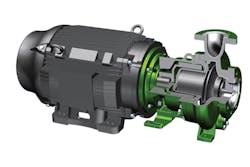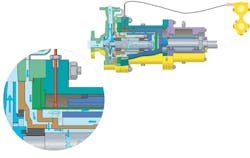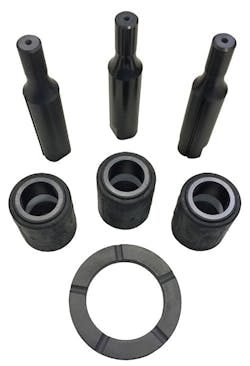Sealless magnetic drive pumps have been in operation for decades, yet they remain a niche solution for solving hazardous pumping applications. While it is true that sealless magnetic drive pumps feature fewer leak paths and their components boast higher reliability than traditional sealed pump designs, the reluctance some engineers have toward acceptance of this proven technology is the legacy of a handful of early historical failures. However, new technologies and tools are now available to help avoid breakdowns and further advance the safety and reliability of magnetic drive pumps.
Sealless pumps fall into two general types: canned motor pumps and magnetic drive pumps. Canned motor pumps utilize an integral close-coupled induction motor as part of the design, with a thin metallic barrier – called the stator liner – between the motor rotor and stator, which acts as the primary containment device. The shaft and motor rotor are supported by bushings that are submerged in and lubricated by the process liquid being pumped. The magnetic drive pump uses a standard electric motor with either a flexible coupling that utilizes a bearing housing arrangement similar to those found on sealed pumps, but where the shaft supports the outer magnet assembly rather than the impeller, or a close-coupled design in which the outer magnet assembly is mounted directly to the motor shaft. The outer magnet assembly is magnetically coupled to the inner magnetic drive, separated by a containment shell acting as the primary containment device. The inner magnet drive is connected to an impeller directly or via an internal shaft and is supported by bushings that are lubricated by the process liquid.
Figure 2. An ultrasonic instrument detects vapor in liquid down to 1 percent by volume. It provides early and direct indication of a potentially damaging operating condition.
Several failure modes are associated with both types of sealless pumps. The first takes place when metallic primary containment devices are used; Inductive heating can occur because of eddy currents induced in the device when the driving magnetic field rotates around it. Overheating of the metallic primary containment device can happen within seconds if the inner rotor assembly is seized, or more slowly if vapor or gas is allowed into the pump. This unexpected heat generation may flash the process liquid and disrupt bearing lubrication. Without lubrication, the bearing system can catastrophically fail, possibly rupturing the primary containment device. For a magnetic drive pump, this condition can be addressed in three ways:
- Elimination of the failure mode with the use of a composite containment shell
- Use of instrumentation to detect and shut down the pump when causal factors are present
- Mitigating the risk of the pump leaking through containment shell failure with secondary containment/control
The use of a nonmetallic containment shell is the preferred method for preventing this type of failure since it prevents the key source of heating that can lead to pump breakdown. Lined process pumps include a nonmetallic containment shell that eliminates eddy current heat generation and its related failures. Metallic magnetic drive pumps have also adopted nonmetallic containment shells. This is a composite shell that is nonconductive and therefore will not result in eddy currents from the magnetic flux passing across it. Composite containment devices are chemically resistant and exceptionally tough. They feature fire, erosion and impact tolerance that in many cases are superior to thinly lined metallic options. Note that the nonmetallic option is not available on canned motor pumps.
The second method of mitigating risk of a potential containment shell failure is to employ instruments that can enable the pump to detect when causal factors or early failure symptoms are present. Historically this has included installing power monitors on the motor to detect a low-load condition from a run-dry situation. Running a sealless pump dry can result in damage because it causes a loss of process liquid flow and heat removal from the containment shell as well as a loss of lubrication for the internal process lubricated bearings. Other monitoring techniques include temperature sensors on the containment shell to detect the temperature rise in the containment shell, leak detection sensors, and low-level or low-flow monitoring of the process liquid to detect if a run-dry or loss of cooling condition might be present. These are indirect measures of a key operating parameter critical for providing bearing lubrication and heat removal. Direct measurement of the gas vapor content of the process liquid is now available using an ultrasonic sensor that is fitted to the pump housing. One ultrasonic instrument is capable of detecting gas bubbles on the order of less than 1 percent by volume.
Image 1. Magnetic drive pumps with nonmetallic primary containment devices are available to comply with API 685 specification.
Secondary containment
The final way of mitigating the effects of containment shell failure is via secondary containment or control. In this situation, the leak path of the process liquid is directed into a secondary housing. For canned motor pumps, the motor housing is the secondary containment barrier. For magnetic drive pumps, the secondary housing is either a secondary containment shell wrapped around the primary shell or the magnetic coupling housing with the inclusion of a leakage restriction device on the outer magnet assembly driving shaft.
A secondary containment shell typically requires thinner primary and secondary containment shells to enable the process fluid in the internal flow regime to provide suitable cooling for both shells. Additionally, the secondary containment shell is subject to the same induction heating as the primary containment shell, so a common failure mode is present even with the secondary shell. Using the magnetic drive housing as either a secondary containment or control requires the use of a leakage restriction device or a mechanical seal. In this situation, the pump acts as a hybrid tandem sealed pump, but the primary seal is the single containment shell of a magnet drive. This arrangement has the advantage of separating the primary and secondary sealing devices such that the initial failure mechanism that caused the primary device to fail does not negatively impact the integrity of the secondary device, in this case, the secondary seal. Another benefit of this arrangement is that it allows the use of a nonmetallic containment shell or a thicker and more robust metallic containment shell.
Another failure mode associated with sealless pumps is bearing failure. As sealless designs have bearings that are lubricated by the process liquid being pumped, a dry-run condition will cause the bearings to run without lubrication. Additionally, certain solids in the process liquid may enter the bearings and cause damage, including seizing the shaft. This failure mode is typically controlled by the instrumentation methods explained above. It is key to flush process piping prior to starting the pump since solids such as weld slag can cause bearing and/or bushing failure.
Image 2. Advanced materials and treatments improve bearing reliability. Hard surfacing, ceramic matrix composites and silicon nitride can provide some resistance to dry-run operating conditions.
Dry run & materials
Several manufacturers have investigated dry-run bearings with exceptionally hard surfaces that provide some level of tolerance to a dry-run condition, including materials like diamond coatings and ceramic matrix composites. These types of bearings should not be relied on for extended dry-run conditions, and it is difficult to know how much remaining life exists in the event of a dry-run condition. Eventually, even these bearings will fail if abused, and the exceptionally hard material may break off from the bearings and be distributed into the pump, causing further damage. Alternately, soft materials such as carbon graphite can be used directly or as a composite in the bearing material to act as a sacrificial lubricating material. When this type of bearing material is used, it is important to monitor wear and replace when necessary.
Several new technologies – nonmetallic containment shells, ultrasonic vapor/gas detection, secondary containment and control and advanced bearings – are improving the reliability of sealless pumps. Meanwhile, the elimination of seal support systems and higher reliability of the components over sealed pumps make sealless pumps a reliable choice for process engineers. As environmental and personnel safety come under increased scrutiny, sealless pumps should be considered as options to reduce operating costs associated with emissions monitoring and seal support systems.
David Clark is the senior engineering manager of Sundyne/HMD Sealless Pumps and has responsibility for Applications, Engineering and Product Development. Clark is a Chartered Engineer and a serving member on API and ASME committees, including API 685 and ASME B73.3. He has implemented numerous sealless products, including high pressure pumps, API vertical pumps, ZeroLoss Composite shells and the VapourView condition monitoring device.





